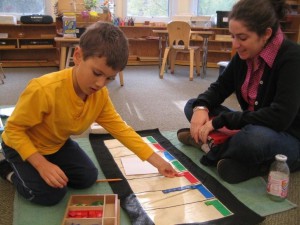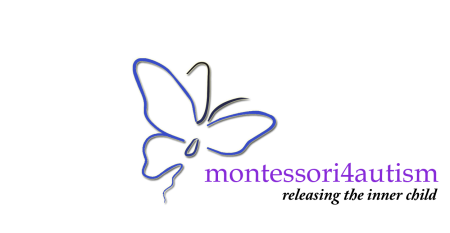Although my son is in a group setting throughout the day, his exposure to group instruction is very limited. Every child in his classroom follows an individualized educational path and curriculum, and group presentations occur only a few times per year.
This beneficial aspect has allowed us to schedule various therapies after school and successfully integrate them into his day. When these therapies are provided at a public school, they are usually “stand alone” and poorly coordinated with the child’s curriculum. I’ve observed repeatedly how school therapists will pull a student out of a class activity at a time determined by the therapists’ busy schedule, not a time coordinated with classroom activities or the child’s needs. Moreover, the therapist often works with the student on a topic unrelated to their current classroom activity and then returns the child to the classroom with the expectation that the child quickly synchronize with the rest of the class, which has already moved on to the next step. This routine is counterproductive, causing stress, confusion, and perhaps attention deficit in children with special needs.
During his three years in a Lower Elementary classroom, my son was supported by a part-time ABA aide on an as-needed basis. This aide, selected and funded by us, was under the supervision of an outside BCBA (Board Certified Behavioral Analyst), who we enlisted to help coordinate David’s outside therapy activities with school activities. Since moving up to the Upper Elementary classroom this fall, David does not have a dedicated aide but receives as-needed assistance from the school’s learning specialist (an individual with a background in special needs) who also provides assistance to many other students at school. I would like to note the critical role that my son’s aides played over the past several years in successfully integrating him into the Montessori classroom and forging his independence. It would usually take me several months each summer to recruit and train the best match from dozens of candidates. We assured the school that it would be our responsibility to provide and pay for the one-on-one aide, with the goal of gradually reducing the aide’s role as my son was reaching a certain level of competence.

David with his aide at Lower Elementary
Since David initially required more individual attention and a higher percentage of direct instruction time than most of the other students, use of an aide was a win-win arrangement which spared the classroom’s lead teacher, or Guide (Montessori’s terminology for a principal teacher), from spending disproportionate time my son. I would like to note the critical role that my son’s aides played over the past several years in successfully integrating him into the Montessori classroom and forging his independence. It would usually take me several months each summer to recruit and train the best match from dozens of candidates. We assured the school that it would be our responsibility to provide and pay for the one-on-one aide, with the goal of gradually reducing the aide’s role as my son was reaching a certain level of competence. Since David initially required more individual attention and a higher percentage of direct instruction time than most of the other students, use of an aide was a win-win arrangement which spared the classroom’s lead teacher, or Guide (Montessori’s terminology for a principal teacher), from spending disproportionate time my son.
Some would say that using a personal aide is inconsistent with core Montessori principles of independent and self-directed learning. However, with the right training and attitude, the aide in our case was the very bridge to that independence. She worked in harmony with the Guide, using ABA methods and “least-to-most prompting”, to foster my son’s independence and maximize his learning. Her responsibilities included:
- Helping David to stay on task as well as to organize and prioritize his work
- Identifying potential triggers of inappropriate behaviors, such as motor stereotypy and repetitive speech, and developing jointly with the Guide a behavioral plan with strategies for their prevention
- Facilitating social interactions, including work on speech and social skills that are specific for my son and transparent to others
- Providing sensory breaks as needed
As classroom aides, we initially employed graduate students, who were in training to become BCBAs, special education teachers, and language pathologists.
As the knowledge of the Montessori component became increasingly important, my son was fortunate to have two aides who either attended a Montessori school, or had previous experience and training in Montessori methods.
Several aspects of the Montessori educational model contribute to an environment that is healthful and low-stress, which is invaluable for fostering confidence, self esteem, and effective learning.
David is not marginalized or stigmatized because of his disability, thanks in part to de-emphasis of group instruction and in part to the range of ages and abilities in the classroom. In addition, the ability to move freely around the predictable “prepared environment” of the classroom promotes learning for David and the other students.

David (left) with a classmate
Like every other child in the classroom, David can spend as much time as he needs on any particular subject, without devoting unnecessary time to the skills he has already mastered. This is particularly helpful for ASD children, who often display uneven skill development that is difficult to address within a typical environment based on group instruction and a standardized curriculum. During the school day, David does not need to be “pulled out” for individualized work; instead, he does it every hour of the day while in class, just like his peers. And if he does need to leave the classroom, once he returns he can resume his work right where he left off. By contrast, at a public school brief “pull out” services would be the only individualized instruction, while the remaining time would consist of standardized instruction.
Since the start of his Montessori schooling, my son has shown a major increase in initiative, self-help skills, and overall independence. At home, he partakes in baking, cooking, unloading the dishwasher, and cleans up after himself. At school, he does classroom chores (such as watering plants, recycling, and serving snacks), basic stitching, and gardening. In time, he will be expected to begin participating in community work.
We were fortunate that both the Elementary School Coordinator and my son’s Guide in Lower Elementary had extensive backgrounds in special education. Specifically, David’s lead Guide had a degree in early education and special needs, with over twenty years of teaching experience, including teaching special needs students in a public school in a self-contained classroom (now called “disability specific”) and at a residential setting. David’s new Upper Elementary Guide also has experience working with ASD children and has been extremely supportive in accommodating David’s needs.
in its emphasis on incremental skill acquisition


